Heritage & Traditions at Aquinas College
1960 to 1969

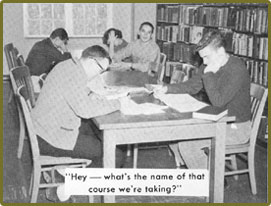
1960
Albertus Magnus Hall of Science opens for classes in September. The building is dedicated
by Grand Rapids' Bishop Allen J. Babcock. The dedicatory address is given by Fr. William
A. Wallace, O.P. entitled "St. Albert and Modern Science." In recognition of Peter
Wege's service to Aquinas, the building is dedicated to the memory of his parents,
Mr. and Mrs. Peter Wege, Sr.
 To hear physics professor Chuck Frydrych reminisce about the opening days of Albertus
Hall and 1960's science faculty, click here. This audio link is from "Historically Speaking," an oral history of Aquinas College.
To hear physics professor Chuck Frydrych reminisce about the opening days of Albertus
Hall and 1960's science faculty, click here. This audio link is from "Historically Speaking," an oral history of Aquinas College.
A language lab with 42 private acoustic-walled booths is installed. Languages taught
include French, Spanish, German and Swahili, taught by a student from Tanganyika.
Some college classes are offered on closed-circuit TV, and Aquinas drama students
perform on WOOD-TV.
The House of Studies opens for Dominican Sisters in training to live on campus. Sisters
begin living and studying in the building in November. During the 1960's, as many
as 70 sisters live in the residence. In the early 1980's, the building is sold to
the college and becomes Hruby Hall, a residence and office building.
A graduate institute in theology for religious sisters is begun, later to become the
Aquinas Institute of Religious Studies (AIRS). Graduate programs in history and English
are begun and masters degrees are offered in those fields until 1967. (These programs
were discontinued.)
Throughout the 1960s, The Yacht Club, in the nearby Eastown neighborhood, provides
off-campus entertainment for students, and a challenge for directors of student life.
 To hear Betty Jennings, former Aquinas faculty member, reminisce about her days policing
The Yacht Club on Wealthy Street with Dean of Women Gertrude Horgan, click here. This audio clip is from "Historically Speaking," an oral history of Aquinas College.
To hear Betty Jennings, former Aquinas faculty member, reminisce about her days policing
The Yacht Club on Wealthy Street with Dean of Women Gertrude Horgan, click here. This audio clip is from "Historically Speaking," an oral history of Aquinas College.
President Bukowski announces that college enrollment tops 1,000 for the first time
in its history. 48% of the student body is from out of town. The College employs 74
full-time faculty.
1961

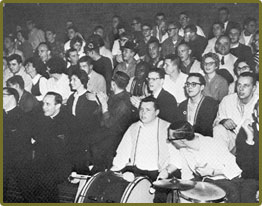

"Orbit," a collection of student creative writing, is published. Film festivals bring
foreign films to campus, some of them controversial, like Bergman's "Virgin Spring."


1962

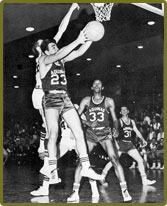
A Michigan Historical Marker is unveiled in central campus to commemorate the 40th
year of Aquinas College as an institution of higher education, and the 75th anniversary
of its founding as Novitiate Normal School. Monsignor Bukowski celebrates his 25th
year as president of the College.
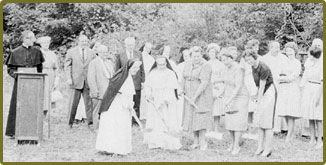

A wooden statue of St. Albertus Magnus, carved by American Seating Company's master
carver Robert E. Hellem, is added to the entrance of Albertus Magnus Hall of Science.
Radio station WXTO continues operating in the tower of the Administration Building.
The station is a collaborative effort with the Grand Rapids Catholic Diocese and is
directed by Father Hugh Michael Beahan. It offers quality music, news, and commentary,
and provides media training for students.
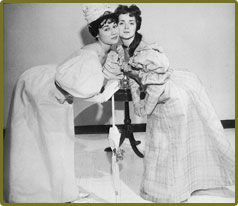
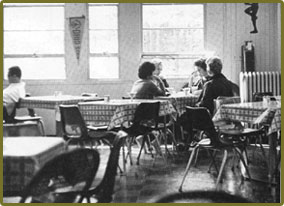
1963
The College purchases Willowbrook, a large house on Robinson Road adjacent to campus, to serve as a residence for senior women. (Men continue to live off campus.)

1964
St. Joseph the Worker Hall opens in September for men students to live on campus.
Located next to Wilcox Park, it is far from Regina Hall, the women's residence hall. In loco parentis rules were in place governing student behavior, with strict curfews and dress codes. To hear alumni Patricia Kozal, Peg Duva and John and Katy McDonald talk about life
in the residence halls in these years, click here. This audio clip is from "Historically Speaking," an oral history of Aquinas College.
To hear alumni Patricia Kozal, Peg Duva and John and Katy McDonald talk about life
in the residence halls in these years, click here. This audio clip is from "Historically Speaking," an oral history of Aquinas College.
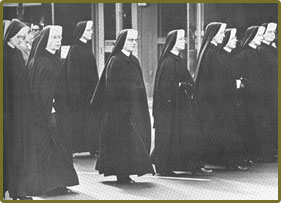
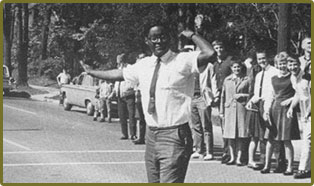
1965


1966

Students line up to register for classes in 1966.
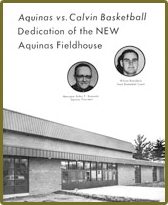

An academic Mass is held at nearby St. Thomas the Apostle parish with Monsignor Bukowski presiding.
1967

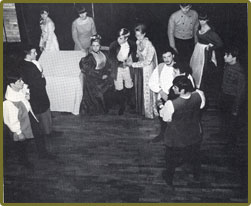

The Carriage House theater provides an intimate venue for productions such this 1967 staging of Dylan Thomas's Under Milkwood, with faculty member Herb Martin (seated) and (l to r) Jim Milanowski, William Schultz, Roberta Zimber, and Theresa Grywalski.
1968
Monsignor Bukowski announces his planned retirement, to be effective the following year. The Board of Trustees sets up a search committee to find his replacement.
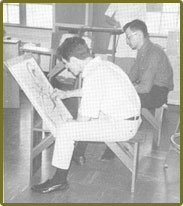
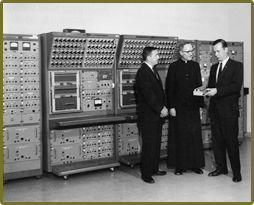

1969
Laymen are admitted to Board of Trustees for the first time. A Lay Advisory Board
has existed since the 1940's but this move inches the College closer to the eventual
legal separation of the college from the Dominican Sisters of Grand Rapids and to
an independent board of Trustees.
 To hear alumnus Russ Hogan talk about this student uprising, click here. This audio clip is from "Historically Speaking," an oral history of Aquinas College.
To hear alumnus Russ Hogan talk about this student uprising, click here. This audio clip is from "Historically Speaking," an oral history of Aquinas College.
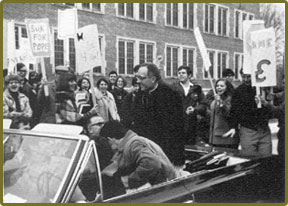
storming the president's office and escorting him around campus in the back of a convertible chanting "Mon Buke! Mon Buke!"


CONTACT INFO
AQ History
Ryan Wendt
aqhistory@aquinas.edu